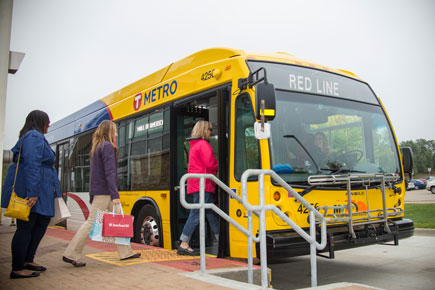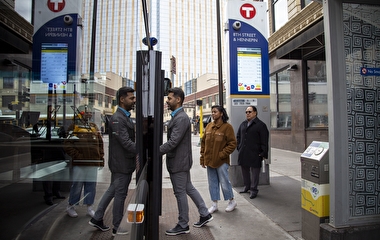Providing innovative public transit is crucial for ensuring that people around the world—whether in large or small cities, suburbs, or rural areas—have a high quality of life. But many questions remain about transit and its potential to address societal challenges, and many opportunities exist to improve efficiency and innovation. Skilled experts are also needed to take new knowledge and solutions and put them into practice.
The new Global Transit Innovations (GTI) program aims to find these answers and educate the next generation of transit leaders and practitioners. GTI was established by CTS in partnership with Yingling Fan, a McKnight Land-Grant Professor at the Humphrey School of Public Affairs, who will serve as GTI director.
“GTI is dedicated to meeting society’s persistent and complex challenges, including auto dependence, energy shortages, the environment, income inequality, and growing disparities in health and well-being,” Fan says.
research and education. Photo: Metro Transit
GTI builds on the Transitway Impacts Research Program (TIRP), which includes a mix of state, regional, and local jurisdictional partners. Since 2006, studies funded under TIRP have explored the complex impacts of transit on land use, property values, job accessibility, public health, and social equity. “The goal of GTI is to expand this research capacity and expertise and take it to a global level,” says Laurie McGinnis, CTS director.
The educational component of GTI aims to attract bright minds to the transit-planning field. The program will foster a global student experience through an international exchange, initially with university students in the U.S. and China. The program will also offer training to educate practitioners and agency staff to implement research findings and recommendations.
“GTI is built on the collective strength of individual relationships and the groundwork laid by prior research collaboration,” Fan says. The first international collaboration among GTI researchers was in 2009, enabled by support from the Peking University-Lincoln Institute Center in Peking, China, and CTS. Currently, GTI has faculty contributors from five different countries: Canada, New Zealand, the United Kingdom, China, and the United States.
Fan notes that GTI defines public transit broadly as any shared passenger transport services that are available for use by the general public. By this definition, transit modes include not only the traditional ones such as buses (city buses, bus rapid transit, commuter buses, etc.), trains (light rail, commuter rail, heavy rail, monorail, streetcar, high-speed rail, etc.), and ferries, but also contemporary Dial-a-Ride, car sharing, and bicycle sharing services.
The GTI website includes ongoing and completed research, publications (working papers, journal articles, research reports, summaries, and briefs), and profiles of current GTI researchers. A new product from Fan is an interactive National Transit Map (see related article).
To learn more about GTI and its activities or to become a partner and participate, please visit the program’s website. You may also sign up to receive periodic updates from GTI.




